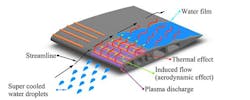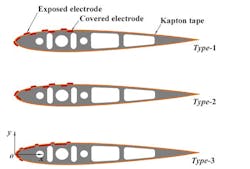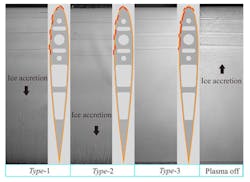Ice buildup on wings, especially prevalent in the extreme cold of higher altitudes (often as low −50°C at 35,000 cruising altitude) is a serious and dangerous occurrence, especially if the ambient moisture conditions are favorable. Aircraft deal with ice prevention (anti-icing) or ice removal (deicing) using a combination of techniques, including liquid-based “weeping wings” that melt the ice; mechanical-based pneumatic boots that move and break the ice film; and thermal approaches using hot-air and electro-thermal systems.
Many jets at present utilize a bleed hot-air system (as hot as 200°C to vaporize the water droplets) to keep flight surfaces above the temperature at which ice will begin to accumulate. However, the widely used approach isn’t viable for next-generation all-electric aircraft that lack combustion engines providing a suitable heat source, or aircraft using composite materials that can’t tolerate the high temperatures.
To overcome these problems, a team comprised of researchers from Northwestern Polytechnical University (Xi'an, Shaanxi, China) and the University of Iowa (Iowa City) has developed and tested a plasma-based deicing system using a surface-dielectric barrier-discharge (SDBD) plasma actuator. This plasma (an ionized gas consisting of positive ions and free electrons with little or no overall electric charge) was developed by a 30-kV ac source between the electrodes that weakly ionizes the air over the dielectric covering the encapsulated electrode. Plasma flow over an actuator has been previously used to control the aerodynamics of aircraft wings by altering the lift and drag for landing and takeoff in a technique known as flow control.
But plasma actuators don't just release an induced wind. "When applying a high voltage, most is converted into heat and the rest is converted into an induced flow or ionic wind over the actuator, so the plasma actuator has both aerodynamic and heat effects," said Xuanshi Meng, an author of the paper. "By coupling the aerodynamic and thermal aspects of the plasma actuator, we have provided a completely new method for efficient icing and flow control."
The downside of plasma flow control is its low efficiency of energy conversion—a large part of the electrical power is transformed into heat energy (here, efficiency is the surface discharge-induced kinetic efficiency versus discharge current is only a few percent). In this case, it’s a good thing if it can be properly controlled and channeled. This plasma approach offers advantages of no moving parts, zero reaction time, broad frequency bandwidths, and relatively low energy consumption. Further, the electrodes (Fig. 1) and actuators can be arranged as desired on the wing surface.
1. This schematic illustration of airfoil model and plasma actuators shows a single SDBD plasma actuator (a), and actuators mounted on airfoil model (b). (Source: AIP Publishing)
The researchers investigated three actuator arrangements, each mounted on a standard NACA 0012 airfoil, with directed plasma flow along different paths. The test sections measured 2.0 m (length), 0.4 m (height), and 0.4 m (width) at a fixed angle of attack of 5°. The sections were made of hard plastic material using additive manufacturing to build it layer-by-layer with a resolution of about 25 µm. The surface was finished with a coating of primer and then wet-sanded to a smooth finish using 1000 grit sandpaper.
The general arrangement of the electrodes, plasma discharge, airflow, and thermal effect (Fig. 2) was customized on three test wings with different arrangements and numbers of buried and exposed electrodes (Fig. 3). The Type-1 actuator was designed to generate an induced flow in the same direction as the incoming flow; the Type-2 actuator generated an induced flow opposite to the incoming flow; and the Type-3 actuator induced flow jets in vertical directions.
2. The general mechanism of the plasma icing control configuration was modified and extended for the three test wing arrangements. (Source: AIP Publishing)
3. Shown are the schematic diagrams of the arrangements of three plasma-based actuator types that were evaluated. (Source: AIP Publishing)
The team performed sets of tests to assess actuator deicing performance with multiple parametric variations, using two-dimensional particle-image-velocimetry (2D-PIV) techniques to assess flow. The surface temperature-distribution measurements were made using an infrared camera operating in the 7.5- to 14-µm spectral range with a sensitivity better than 0.02°C. The freestream air velocity before actuation of the plasma source was fixed at 40 meters per second while the static air temperature was set at −5°C, and the liquid water content (LWC) of the incoming airflow was set 1 g/m3. Since water droplet size has a significant effect on aircraft icing, the study used super-cooled water droplets ranging from 10 to 100 µm.
The associated test imagery demonstrates the ice accumulation and subsequent elevation, after an approximate two-minute delay to allow the system to reach thermal equilibrium (Fig. 4). For the Type-1 actuator, the plasma actuation ensures that there’s no ice on the leading edge of the airfoil, and the ice accumulation appears at approximately 57% chord point c of the model (the chord is the distance from the leading edge to the trailing and is denoted by the symbol c). For the Type-2 actuator, there’s a little ice accumulation on the leading edge, but the ice accumulation is delayed to 81% c. Finally, the Type-3 actuator significantly prevented the appearance of the solid ice over the entire lower surface of the airfoil.
4. These are images of the Ice accumulation for air velocity of 40 m/sec, temperature of −5°C, and liquid water content of 1.0 g/cubic meter after a thermal-equilibrium settling time of 112 seconds. Note the differences in ice accretion among the three arrangements. (Source: AIP Publishing)
The team concluded that this plasma-based icing control can stop the supercooled droplets from forming ice on the surface of the vehicle without extreme high temperatures. Meng added, "By coupling the aerodynamic and thermal aspects of the plasma actuator, we have provided a completely new method for efficient icing and flow control."
The team’s published paper “Mechanism study of coupled aerodynamic and thermal effects using plasma actuation for anti-icing” appeared in the journal Physics of Fluids published by American Institute of Physics (an open-access pdf version is here). It provides much more detail on the concept, physical arrangements, test conditions, and test results from various perspectives.
About the Author

Bill Schweber
Contributing Editor
Bill Schweber is an electronics engineer who has written three textbooks on electronic communications systems, as well as hundreds of technical articles, opinion columns, and product features. In past roles, he worked as a technical website manager for multiple topic-specific sites for EE Times, as well as both the Executive Editor and Analog Editor at EDN.
At Analog Devices Inc., Bill was in marketing communications (public relations). As a result, he has been on both sides of the technical PR function, presenting company products, stories, and messages to the media and also as the recipient of these.
Prior to the MarCom role at Analog, Bill was associate editor of their respected technical journal and worked in their product marketing and applications engineering groups. Before those roles, he was at Instron Corp., doing hands-on analog- and power-circuit design and systems integration for materials-testing machine controls.
Bill has an MSEE (Univ. of Mass) and BSEE (Columbia Univ.), is a Registered Professional Engineer, and holds an Advanced Class amateur radio license. He has also planned, written, and presented online courses on a variety of engineering topics, including MOSFET basics, ADC selection, and driving LEDs.





